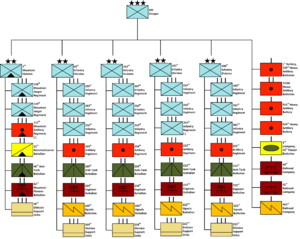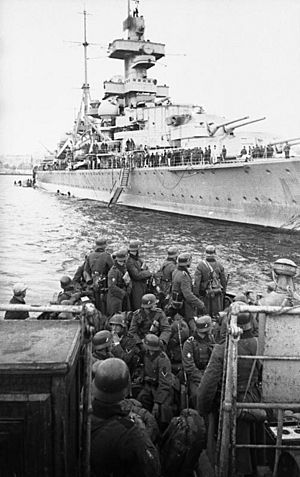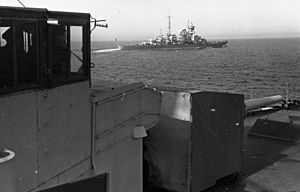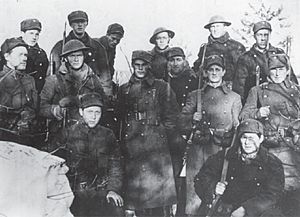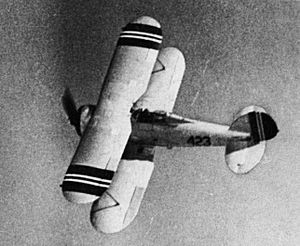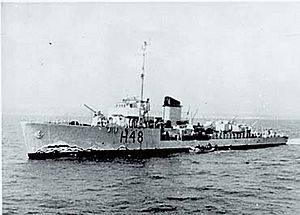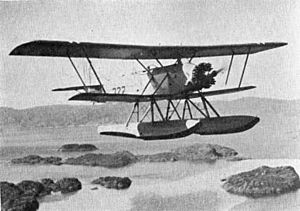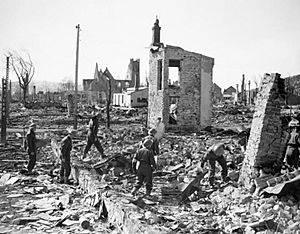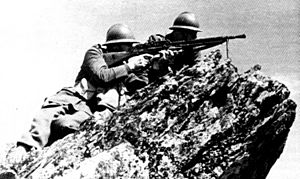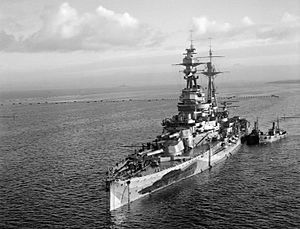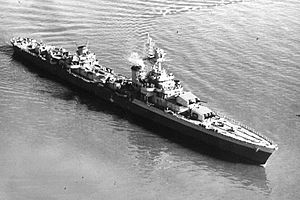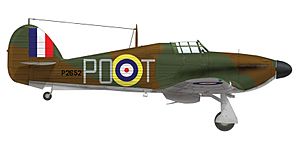Norwegian campaign order of battle facts for kids
The German invasion of Denmark and Norway in April 1940 was a secret operation called Weserübung, which means "Weser Exercise." This invasion was met by the Norwegian military, which was only partly ready for war. They were also joined by a team of soldiers from the British, French, and Free Polish armies. This article lists the different military groups and units that took part in this important campaign.
Germany's Invasion Forces
The German military was very organized for this invasion. They used their army, air force, and navy to attack Denmark and Norway.
German Army Group XXI
On March 1, 1940, the German 21st Army Corps was renamed Group XXI. This group was put in charge of invading Norway. They had two Mountain Divisions and five Infantry Divisions for this big task. General Nikolaus von Falkenhorst led Group XXI.
Here are some of the main army units:
- 2nd Mountain Division
- This division fought in northern Norway.
- One of its regiments, the 137th, even parachuted into Narvik on May 15.
- 3rd Mountain Division
- 69th Infantry Division
- 163rd Infantry Division
- Parts of this division landed in Oslo, Kristiansand, Arendal, and Stavanger, starting on April 9.
- 181st Infantry Division
- This division arrived in Trondheim by April 15, mostly by aircraft.
- 196th Infantry Division
- Most of this division landed in Oslo by April 15.
- 214th Infantry Division
- This division landed in Kristiansand and Arendal on April 17 and 18.
- 170th Infantry Division
- This division entered Denmark through the southern part of the Jutland peninsula on April 9.
- 198th Infantry Division
- This division took control of Copenhagen, Zealand, and the southern Danish islands on April 9.
- German 11th Motorized Rifle Brigade
- This unit was part of the force that invaded Denmark.
German Air Force (Luftwaffe)
The German Air Force, known as the Luftwaffe, played a big role in the invasion. Its X Air Corps was in charge of all Luftwaffe units in Operation Weserübung.

- Parachute Troops
- Small groups of paratroopers were used to take over important airfields in northern Denmark (like Aalborg Airport), near Stavanger (Sola Airport), and Oslo (Fornebu Airport).
- Aircraft Available
- The Luftwaffe had many planes ready for the invasion:
- 102 fighter planes.
- 233 bomber planes.
- 39 dive bombers.
- 165 reconnaissance planes (for scouting).
- 582 transport planes (for moving troops and supplies).
- The Luftwaffe had many planes ready for the invasion:
The German Navy, or Kriegsmarine, was vital for transporting troops and attacking coastal areas.
- Battleship Force
- This force included powerful battleships like the Gneisenau and Scharnhorst.
- Objective: Narvik
- A group of warships, including several destroyers, headed for Narvik. They carried soldiers from the 3rd Mountain Division. Many of these destroyers were sunk or damaged in battles.
- Cargo ships carrying army equipment and supplies were also sent to Narvik, but some were sunk or captured.
- Objective: Trondheim
- Another warship group, led by the cruiser Admiral Hipper, went to Trondheim. They transported more mountain troops and engineers.
- Supply ships for Trondheim were also attacked or captured.
- Objective: Bergen
- Warship Group Three, including cruisers like the Köln and Königsberg, aimed for Bergen. The Königsberg was damaged by Norwegian guns and later sunk by British planes.
- A troop ship, the Rio de Janeiro, carrying soldiers for Bergen, was sunk by a Polish submarine.
- Objectives: Kristiansand and Arendal
- Warship Group Four, with the cruiser Karlsruhe, went to Kristiansand and Arendal. The Karlsruhe was later sunk on its way back to Germany.
- Objectives: Oslo and Oslofjord
- Warship Group Five, including the cruisers Blücher and Lützow, aimed for Oslo. The Blücher was famously sunk by Norwegian coastal guns at Oscarsborg in the Oslofjord. The Lützow was also damaged.
- Other Objectives in Denmark
- Other German naval groups targeted places like Egersund, Korsör, Nyborg, Copenhagen, Middelfart, Esbjerg, and Thyborön in Denmark. These groups included minesweepers, patrol craft, and cargo ships.
- U-Boat Force
- German submarines, called U-boats, were sent to patrol different areas around Norway and the Shetland Islands. They were divided into several groups. Some U-boats were sunk during the campaign.
Norway's Defenders
The Norwegian military was not fully ready when the Germans attacked. Many units were only partly mobilized.
Norwegian Army
The Norwegian army's main fighting unit was the regiment, not the division. Each regiment was supposed to have about 3,750 soldiers. In total, Norway had about 60,000 soldiers by 1940, but only 55,000 were well-prepared. General Kristian Laake was the army commander at first, but he was replaced by Colonel Otto Ruge on April 11.
Here are some of the Norwegian Army units:
- The Royal Guards battalion: This was the only unit in Southern Norway that had proper training before the war.
- Divisions: Norway had six divisions, but they were more for administration than fighting. Each division had several infantry regiments.
- 1st Division (Halden)
- 2nd Division (Oslo)
- 3rd Division (Kristiansand)
- 4th Division (Bergen)
- 5th Division (Trondheim)
- 6th Division (Harstad): This division was better prepared than others because it had been on duty during the Finnish Winter War. It formed two light infantry brigades during the campaign.
- Additional Units: These included Dragoon (cavalry) regiments, Artillery regiments, Mountain Artillery Battalions, and special battalions like the Alta Battalion and Varanger Battalion.
When the Germans invaded, only some Norwegian land units were immediately ready, including the Royal Guards, parts of the 1st, 2nd, 3rd, 4th, and 5th Divisions, and the fully prepared 6th Division.
Norwegian Army Air Service
The Norwegian Army Air Service had a mix of fighter, bomber, and training planes.
- They had 11 Gloster Gladiator fighter planes (7 ready to fly).
- They also had reconnaissance/bomber planes like the Caproni Ca.310 and Fokker C.V.
- Most of their planes were destroyed or captured by the Germans. Only a few managed to fly to Finland.
The Royal Norwegian Navy fought bravely but was outnumbered.
- Coastal Defence Ships: Two ships, the Eidsvold and Norge, were sunk on April 9.
- Destroyers: Norway had 7 destroyers, but some were sunk, captured, or scuttled (sunk by their own crew). Only a few managed to escape to the United Kingdom.
- Minelayers: They had 11 minelayers, which were used to lay mines in the water. Many of these were captured.
- Minesweepers: They had 8 minesweepers, used to clear mines.
- Submarines: Norway had 9 submarines. Some were damaged, scuttled, or captured, while one managed to escape to the United Kingdom.
- Torpedo Boats: They had 17 torpedo boats, small fast ships that carry torpedoes. Many were captured or sunk.
- Patrol Boats: They also had 58 patrol boats.
The Royal Norwegian Navy Air Service mostly used seaplanes for reconnaissance and torpedo attacks.
- They had 6 Heinkel He 115 seaplane bombers, all ready to fly.
- They also used Marinens Flyvebaatfabrikk M.F.11 seaplanes for scouting.
- Four Heinkel He 115s were able to escape to the United Kingdom, while some other planes flew to Finland.
Allied Support Forces
The Allies sent several forces to help Norway fight the German invasion.
Mauriceforce
Led by Major-General Adrian Carton de Wiart, this group started landing at Namsos on April 14.
- It included the British 146th Infantry Brigade and the French 5e Demi-Brigade Chasseurs Alpins (mountain infantry).
Sickleforce
Commanded by Major-General Bernard Paget, this force landed at Åndalsnes starting April 18.
- It included the British 15th Infantry Brigade and the 148th Infantry Brigade.
- They also had anti-aircraft batteries to defend against air attacks.
Rupertforce
Led by Major-General Pierse Joseph Mackesy, this force landed at Harstad, north of Narvik, between April 15 and May 5.
- This force included the British 24th (Guards) Brigade.
- French units like the 27e Demi-Brigade de Chasseurs Alpins and the 13th Foreign Legion Demi-Brigade also joined.
- The Polish Independent Highland Brigade also landed at Harstad.
- They had some artillery and independent companies (specialized units).
North Western Expeditionary Force
This force was formed on May 13, 1940, by reorganizing British forces in the Narvik area. Lieutenant-General Claude Auchinleck commanded it.
- It included the 24th (Guards) Brigade and several Independent Companies.
- They also had strong anti-aircraft defenses, with many anti-aircraft guns.
The British Royal Navy provided significant naval support.
- They had 4 battleships, 2 battlecruisers, and 3 aircraft carriers (one, Glorious, was sunk).
- They also had 5 heavy cruisers, 5 light cruisers, and 6 anti-aircraft cruisers.
- Many destroyers were involved, including 7 Tribal-class destroyers. Some destroyers were sunk.
- They also used sloops (smaller warships), submarines (some were sunk or captured), and minesweepers.
The French Navy contributed to the Allied effort.
- They sent 2 cruisers, Émile Bertin and Montcalm.
- They also had 4 auxiliary cruisers and 9 destroyers (one, Bison, was sunk).
- Many transport ships were used to carry troops and supplies.
- One submarine, Rubis, was also part of their force.
Polish naval forces, operating from exile, also joined the Allies.
- They had 3 destroyers, including Błyskawica and Grom (which was sunk).
- One submarine, Orzeł, was also part of their fleet (it was later sunk).
- They used 3 troopships to transport soldiers.
Royal Air Force (RAF) in Norway
The British Royal Air Force sent fighter squadrons to Norway.
- No. 263 Squadron RAF flew Gloster Gladiator fighter aircraft.
- No. 46 Squadron RAF flew Hawker Hurricane fighter aircraft.


